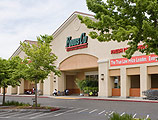The office market is grim, barreling toward grimmer. According to Newmark, the national vacancy rate in Q3 topped 17.6 percent. Downtown Oakland stands at 21.3 percent, while San Francisco is outpacing the pack at 24.1 percent. With almost no traditional financing available and a bid-ask spread wider than the Grand Canyon, the nationwide office market is at best hibernating.
Those praying for its awakening (basically, everyone in real estate) need office workers to return. This is why some office landlords are quietly applauding Big Tech’s mass firings, hoping the thousands of now unemployed engineers will portend a buyer’s market for talent, one so strong that employers can insist that the office actually be part of office work. Some landlords might even welcome another dot.com collapse, likening it to a Covid vaccination: nasty side effects at first, but a much better chance of long-term survival.
The layoffs could be having an effect. JLL reports a slow return of workers to San Francisco—occupancy rising to 40 percent since Labor Day—and BART ridership up a tad.
This big-picture scenario will likely smack a few speed bumps at the street level. As it happens, I walk past one of our Palo Alto office buildings every day. It’s fully leased to a tech company, but seldom is anyone inside. Last week, a bearded guy in mismatched sweats was swiping his key fob as I passed by. I remarked that the building appeared empty most days, and asked about its occupancy.
“Maybe five percent,” the techie replied. “Six, seven guys on average. We’re much more efficient working from home.”
“Really? More efficient? Does management agree with that?”
“Probably not, they want us back. But it’s not happening. During Covid, we learned to love the quiet at home and that lay-out inside is really noisy.” He pointed toward the rows of long tables, the typical co-working floor plan that jams dozens side by side. “We only come in when we can’t work at home. Or when we need to collaborate, but that sucks if anyone else is around.”
“Why?”
“Way too noisy. We need smaller rooms so that three or four of us can get together and work without interruptions.”
“Oh, you mean like actual offices?” Just what this tenant had ripped out when it leased the building.
“Yes, exactly. Offices our small teams could cluster in, maybe some for two guys, others for four.” He added that Google is doing this; it figured out that its engineers loathe working cheek by jowl and has been redesigning its interiors to add more offices ever since.
In suggesting that forcing a return to the office would result in house-to-house Fallujah warfare with employees, the techie jammed another thumbtack in the office coffin. He said engineers now prefer Zooming to in-person meetings. Why? Because concentrating on numbers on your own screen is more efficient than awkwardly peering over someone’s shoulder in the office.
But the sales and marketing guys must be returning? Don’t they come together to pound their chests, swap lies about their deals and do shots in the break room? Nope, he swore they don’t come in either, and that, if anyone, it’s the finance and accounting people who reluctantly show up at headquarters.
Finally, he pointed out that Covid effectively transformed Silicon Valley from suburban to urban, freeing the techies to move much farther away, to towns where they could afford four-bedroom homes, to boondocks from which they can no longer commute. Even if office space were as comfy as home and more fun than free beer, a couple hour drive would be a deal-breaker.
In double-checking these certitudes with another techie, I asked what it would take to get Gen Z back downtown. “Private offices, man. Microsoft gives them to everybody.
What? Old-school offices work better than WeWork playpens? And it took the virus for everyone to figure that out? That Gen Z may insist we plunge forward into the past is truly ironic, but reinstalling private offices in the growing legions of ghost buildings may be worth a try.






















